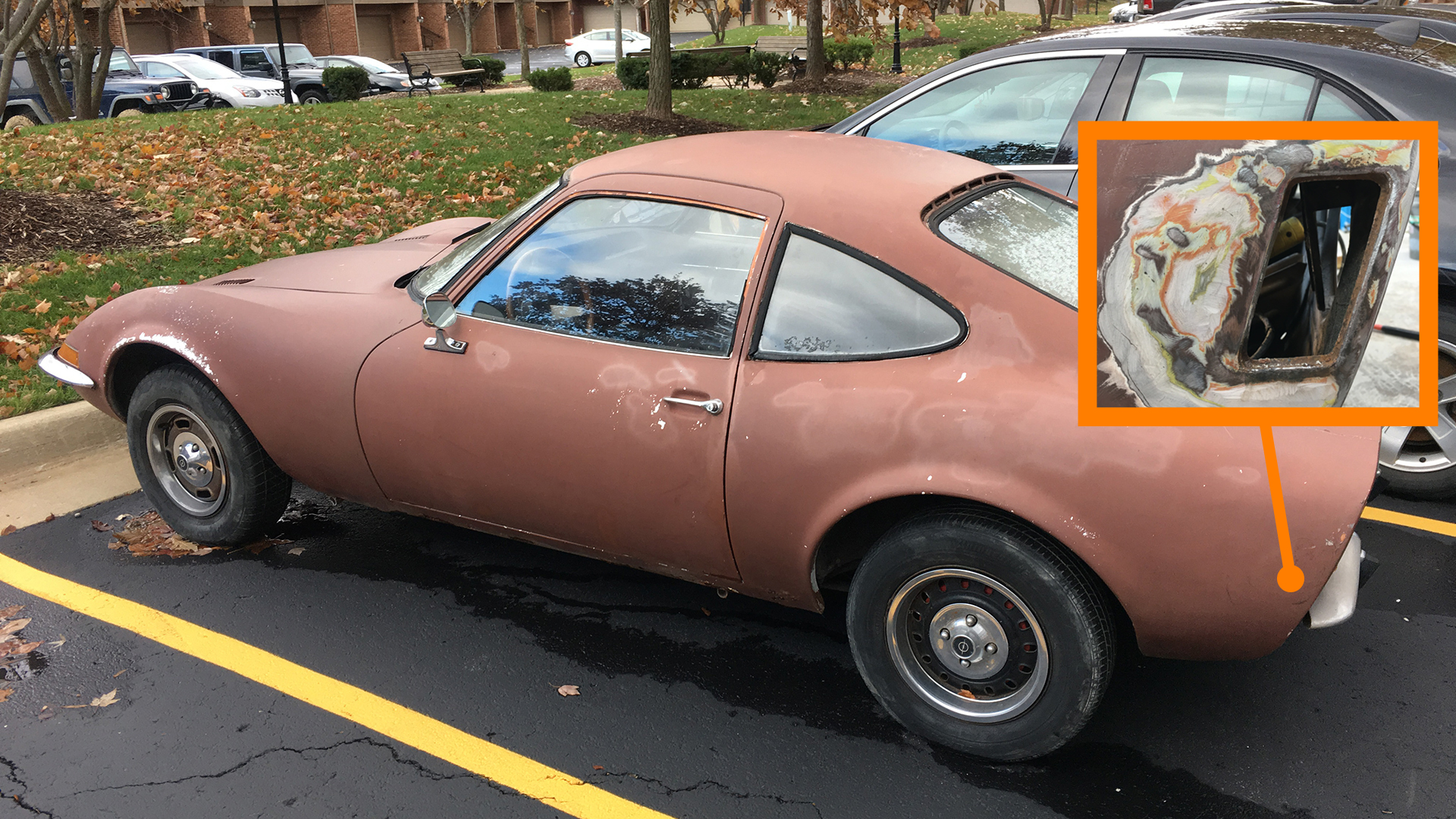

We may earn revenue from the products available on this page and participate in affiliate programs. Learn more ›
It’s been more than a year since I last updated you on the status of my Opel GT. Like any owner of a project car, I’ve gone through spurts of wrenching and gaps of doing absolutely nothing. The car has been staying at my parents’ house while I was living in an apartment, but I recently bought my first house with a two-car garage, so I won’t be able to use space as an excuse for much longer.
That said, I didn’t buy this to be only my car. I bought it as a way to get closer to my dad, and he’s done just as much, if not more, work on it than I have. We’ve spent many a Saturday whittling away at the endless to-do list, and it’s been fulfilling hanging out in the garage like he used to do with my mom and Uncle Doug in his younger days.
Our Opel project is a lot more involved than replacing a few worn pieces and eeking the car through state inspection. Throughout the past few years, we stripped the car down to a roller, sanded down select areas, performed some minor metalwork, and completely restored the entire front suspension and steering rack. Those blogs are incoming, but I wanted to start with a hilarious detail that I’m sure many people could relate to. As I’ve worked on the car, I uncovered little treasures left by one of the many previous owners of this beat-up micro coupe. In one instance, I discovered the car once had rear-end side markers that were completely deleted.

My reenactment of the Badlands dig in the original Jurassic Park here was completely unexpected. The goal for one of our wrenching days was to sand down any spots that looked rusty so we could spray the bare metal with rust inhibitor until we could do a full respray. As mentioned in previous posts, this car has been hit in both the front and the rear, and the back end is pretty wonky. In addition to the entire tail panel being punched in and unlevel, the corners were flaking and clearly had rust bubbling underneath the surface.
With an air sander and a coarse circular grinding pad, I went to work. I chipped away at the brown exterior shell and into the yellow, white, and orange Fruit Stripe paint underneath. I’ll never know what this car’s actually been through, but it’s clearly seen some tough times.

As I expanded out from the starting point, I unearthed numerous spots of Bondo, but one area seemed thicker and more deliberate than the others. Bzzz, bzzz, bzzz, I started to see a corner form. As I followed the lines, I eventually found a vertical rectangle that had been completely filled in with the hardened paste. I checked the inside of the panel, and somebody had used fiberglass to create a backside support. After some more sanding, I loosened it up and punched it out. On each side of the car, there are supposed to be side markers, and somebody from the past decided that they either didn’t want to pay for new ones or just didn’t care to have them. If I had to guess, it might be because the passenger-side rear corner was smashed in, and the light housing might not fit into its setting correctly, so the person abandoned them altogether.

The kid in me loved this. My first dream job was to be a paleontologist digging up dinosaur bones, and this gave me a funny rush of adventure. On the other side of the coin, the adult in me was slightly annoyed. I was glad we were making more progress, but that just added another $100 to the restoration bill, as each marker costs $50 before shipping on Opel GT Source, my guiding north star. I’ll pay it, though, because I’m trying to get this thing back to semi-original form, and I don’t see a reason not to reinstall them. I just wonder what else was hidden from view.
This is an extremely minor and easy fix in the grand scheme of the build, but it was a goofy surprise nonetheless. Less delightful is the fact that I find more Bondo every time I use the sander. At first, I wanted to sand everything down to bare metal, but I’m not sure the car would still be whole if I did. But that’s a problem for future me, as paint is still a faraway hope that will be the final piece of the plan.

On the docket, the engine needs a rebuild, and we have to completely redo the swiss cheese floor pans and rocker panels. I’d be lying if I said I didn’t feel some sort of pressure mounting due to the amount of time that has passed, but I’m trying not to let that ruin the process. Bit by bit, we’re going to get this thing in shape, and eventually, one more car with hidden headlights will be back on the road.
Read More From The Garage
- The Drive’s Project Cars: Introducing Tony’s 1970 Opel GT
- Project Opel GT Assessment: Dream Restoration or Scrap Metal?
- The Drive’s Project Cars: Introducing Hank’s 1969 Dodge Charger
- 1969 Dodge Charger Project Car Update: Let’s Deal With That Floating Steering
- 1969 Dodge Charger Project Update: Understanding That Better Is a Relative Term
